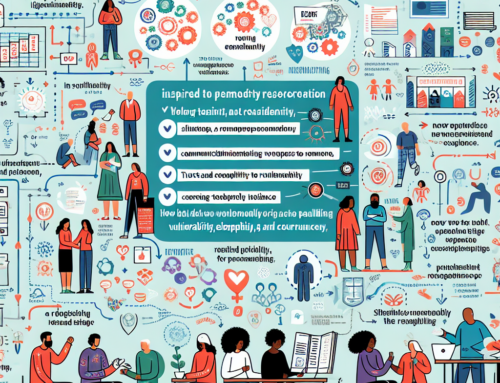
The Power of Vulnerability: Lessons for Leaders from Brené Brown
Brené Brown, a renowned researcher and author, has become a household name in recent years for her work on vulnerability and shame. While her research has been widely applied in the fields of psychology and personal growth, it also holds valuable lessons for leaders in the business world. In this article, we will explore the power of vulnerability and how leaders can apply Brené Brown’s insights to become more effective and authentic in their roles.
First and foremost, it is important to understand what vulnerability means in the context of leadership. Many people associate vulnerability with weakness or being exposed to harm. However, according to Brown, vulnerability is the birthplace of innovation, creativity, and change. It is the willingness to show up and be seen, even when there are no guarantees. In a business setting, this means being open to taking risks, admitting mistakes, and being authentic with your team.
One of the key lessons from Brown’s work is that vulnerability is not a one-time event, but a daily practice. As leaders, we are often expected to have all the answers and be in control at all times. However, this can create a culture of fear and perfectionism, which stifles creativity and innovation. By embracing vulnerability and being open about our own struggles and imperfections, we create a safe space for our team to do the same. This leads to a more authentic and collaborative work environment, where everyone feels valued and supported.
Another important aspect of vulnerability in leadership is the ability to have difficult conversations. As leaders, we often shy away from addressing issues or giving feedback because we fear it may make us look weak or cause conflict. However, avoiding these conversations only leads to bigger problems down the line. Brown emphasizes the importance of being vulnerable and honest in these situations, as it allows for deeper connections and trust to be built within the team. By being vulnerable and owning our mistakes, we also set an example for our team to do the same, creating a culture of accountability and growth.
In addition to embracing vulnerability, Brown also stresses the importance of setting boundaries as a leader. Many leaders struggle with saying no and taking on too much, which can lead to burnout and resentment. Brown’s research shows that setting boundaries is an act of self-care and self-respect, and it allows us to show up as our best selves for our team. By setting clear boundaries and communicating them effectively, we create a healthier work-life balance and model healthy behavior for our team.
Finally, Brown’s work on vulnerability also highlights the importance of empathy in leadership. Empathy is the ability to understand and share the feelings of others, and it is a crucial skill for effective leadership. By being vulnerable and open about our own struggles, we create a space for empathy to thrive within our team. This leads to better communication, stronger relationships, and a more supportive work environment. As leaders, it is important to remember that vulnerability and empathy go hand in hand, and by practicing both, we can create a more compassionate and successful team.
In conclusion, Brené Brown’s research on vulnerability has valuable lessons for leaders in the business world. By embracing vulnerability, setting boundaries, having difficult conversations, and practicing empathy, we can become more authentic and effective leaders. It is important to remember that vulnerability is not a weakness, but a strength that allows us to connect with others and create a culture of trust and growth within our teams. As Brown says, ”Vulnerability is the birthplace of love, belonging, joy, courage, empathy, and creativity. It is the source of hope, empathy, accountability, and authenticity.” So let us embrace vulnerability and lead with courage and authenticity.
Embracing Vulnerability: How Brené Brown’s Teachings Can Transform Your Leadership Style
When we think of great leaders, vulnerability may not be the first trait that comes to mind. In fact, many of us have been taught to believe that vulnerability is a sign of weakness and should be avoided at all costs. However, renowned researcher and author Brené Brown has challenged this belief and has shown us that vulnerability is actually a key component of effective leadership.
In her groundbreaking book, ”Daring Greatly: How the Courage to Be Vulnerable Transforms the Way We Live, Love, Parent, and Lead,” Brown delves into the concept of vulnerability and how it can positively impact our personal and professional lives. Through her research, she has discovered that vulnerability is not a weakness, but rather a strength that allows us to connect with others, build trust, and ultimately become better leaders.
So, how exactly can embracing vulnerability transform your leadership style? Let’s take a closer look at some of the key lessons we can learn from Brené Brown.
Lesson #1: Vulnerability is the birthplace of innovation and creativity.
As leaders, we are often expected to have all the answers and be in control at all times. However, this mindset can actually hinder our ability to innovate and come up with new ideas. Brown argues that vulnerability is necessary for creativity and innovation to thrive. When we allow ourselves to be vulnerable and open to new ideas, we create a safe space for our team members to do the same. This leads to a more collaborative and innovative work environment.
Lesson #2: Vulnerability builds trust and strengthens relationships.
In order to lead effectively, we must have the trust and support of our team members. And vulnerability is a key ingredient in building trust. When we are vulnerable, we show our authentic selves and allow others to see us as human, with flaws and imperfections. This creates a sense of relatability and authenticity that can strengthen relationships and foster a sense of camaraderie within the team.
Lesson #3: Vulnerability allows for honest and open communication.
One of the biggest challenges in leadership is creating a culture of open and honest communication. Many times, team members may feel hesitant to speak up or share their thoughts and ideas for fear of judgment or criticism. However, when leaders embrace vulnerability, it sets the tone for open and honest communication. By being vulnerable and admitting our own mistakes and shortcomings, we create a safe space for others to do the same. This leads to more meaningful and productive conversations within the team.
Lesson #4: Vulnerability leads to growth and resilience.
As leaders, we are constantly faced with challenges and setbacks. And it is during these times that vulnerability can be our greatest strength. When we allow ourselves to be vulnerable and acknowledge our struggles, we open ourselves up to growth and resilience. By embracing vulnerability, we learn to embrace failure as a learning opportunity and become more resilient in the face of adversity.
Lesson #5: Vulnerability requires courage and bravery.
It takes courage and bravery to be vulnerable, especially in a society that often views vulnerability as a weakness. However, as Brown puts it, ”vulnerability is not winning or losing; it’s having the courage to show up and be seen when we have no control over the outcome.” As leaders, we must have the courage to be vulnerable and show up authentically, even when it may be uncomfortable or scary. This not only allows us to lead with integrity, but it also inspires others to do the same.
In conclusion, Brené Brown’s teachings on vulnerability have the power to transform our leadership style. By embracing vulnerability, we can foster innovation, build trust, improve communication, and ultimately become more resilient and effective leaders. So, let’s take a cue from Brown and dare to be vulnerable in our leadership journey.
Leading with Courage: Applying Brené Brown’s Vulnerability Principles in the Workplace
Brené Brown, a renowned researcher and author, has become a household name in recent years for her work on vulnerability and courage. While her teachings have been widely applied in personal growth and relationships, they also hold valuable lessons for leadership in the workplace. In this article, we will explore some of Brené Brown’s vulnerability principles and how they can be applied in a professional setting.
First and foremost, it is important to understand what vulnerability means in the context of leadership. According to Brown, vulnerability is not a sign of weakness, but rather a strength. It is the willingness to show up and be seen, even when there are no guarantees. In the workplace, this can manifest as being open and honest about one’s mistakes, fears, and uncertainties. It requires a level of courage and authenticity that can be intimidating, but ultimately leads to stronger and more effective leadership.
One of the key principles of vulnerability in leadership is the ability to embrace imperfection. In a society that values perfection and success, it can be tempting for leaders to hide their flaws and mistakes. However, Brown argues that true leadership requires acknowledging and owning our imperfections. This not only creates a more authentic and relatable leader, but also sets the tone for a culture of acceptance and growth within the organization.
Another important aspect of vulnerability in leadership is the willingness to take risks and be uncomfortable. In the workplace, this can mean stepping out of one’s comfort zone and trying new approaches or ideas. It also means being open to feedback and criticism, and using it as an opportunity for growth. Brown emphasizes the importance of being vulnerable enough to take risks, even if it means potentially failing or being rejected. This type of vulnerability can lead to innovation and growth within a team or organization.
In addition to embracing imperfection and taking risks, vulnerability in leadership also involves setting boundaries and being clear about expectations. This may seem counterintuitive, as vulnerability is often associated with being open and exposed. However, Brown argues that setting boundaries is an act of vulnerability because it requires being honest about one’s needs and values. In the workplace, this can mean setting clear expectations for team members and holding them accountable, while also being open to feedback and adjusting those expectations as needed.
Another important aspect of vulnerability in leadership is the ability to empathize and connect with others. Brown defines empathy as ”feeling with people,” rather than ”feeling for people.” This requires leaders to put themselves in their team members’ shoes and truly understand their perspectives and experiences. This type of vulnerability can lead to stronger relationships and a more cohesive and supportive team.
Finally, vulnerability in leadership also involves being resilient and embracing failure. Brown argues that vulnerability and courage are not one-time acts, but rather a daily practice. This means being able to bounce back from failures and setbacks, and using them as opportunities for growth and learning. In the workplace, this can mean acknowledging and learning from mistakes, rather than trying to hide or ignore them. It also means being open to trying again and taking risks, even after experiencing failure.
In conclusion, Brené Brown’s vulnerability principles have valuable applications in the workplace, particularly in leadership roles. Embracing imperfection, taking risks, setting boundaries, empathizing with others, and being resilient are all important aspects of vulnerability in leadership. By incorporating these principles into their leadership style, individuals can create a more authentic, courageous, and effective workplace culture. As Brown herself says, ”Vulnerability is the birthplace of innovation, creativity, and change.” So let us embrace vulnerability and lead with courage in our workplaces.
The Connection Between Vulnerability and Trust in Leadership: Insights from Brené Brown
When we think of leadership, vulnerability may not be the first word that comes to mind. In fact, many of us may associate vulnerability with weakness or a lack of control. However, according to renowned researcher and author Brené Brown, vulnerability is actually a key component of effective leadership. In her groundbreaking work on vulnerability and shame, Brown has uncovered valuable insights on the connection between vulnerability and trust in leadership. Let’s take a closer look at what she has to say and how we can apply these lessons in our own leadership roles.
First and foremost, it’s important to understand what vulnerability really means. According to Brown, vulnerability is not about being weak or powerless. Instead, it is about having the courage to show up and be seen, even when there are no guarantees. It is about embracing our imperfections and being willing to take risks and make mistakes. In the context of leadership, vulnerability means being open and honest with our team members, admitting when we don’t have all the answers, and being willing to learn and grow alongside them.
One of the main reasons why vulnerability is so important in leadership is because it builds trust. When we are vulnerable with our team, we are showing them that we trust them enough to be open and honest. This creates a safe and supportive environment where team members feel comfortable sharing their own vulnerabilities and taking risks. As Brown puts it, ”vulnerability is the birthplace of innovation, creativity, and change.” When we are vulnerable, we are more open to new ideas and perspectives, which can lead to breakthroughs and growth for our team and organization.
However, being vulnerable as a leader does not mean sharing every personal detail or emotion with our team. It’s important to set boundaries and be selective about what we share. As Brown explains, ”vulnerability without boundaries is not vulnerability.” This means being mindful of our own emotional state and not burdening our team with our personal struggles. It also means being aware of our team’s boundaries and respecting their privacy. Vulnerability should always be a two-way street, with mutual trust and respect.
Another important aspect of vulnerability in leadership is the ability to embrace and learn from failure. As leaders, we are often expected to have all the answers and make the right decisions. However, this is not always possible. When we make mistakes or fail, it can be tempting to hide or deflect the blame. But according to Brown, the most effective leaders are the ones who are willing to own their mistakes and use them as opportunities for growth and learning. This not only builds trust with our team, but it also sets a positive example for how to handle failure and setbacks.
In addition to building trust and fostering innovation, vulnerability in leadership also leads to stronger and more authentic relationships. When we are vulnerable with our team, we are showing them that we are human and that we value their input and contributions. This creates a sense of belonging and connection, which is essential for a high-performing team. As Brown states, ”vulnerability is the glue that holds relationships together.”
In conclusion, Brené Brown’s insights on vulnerability and leadership remind us that being vulnerable is not a weakness, but a strength. It takes courage to be vulnerable, but the rewards are worth it. By embracing vulnerability, we can build trust, foster innovation, and cultivate authentic relationships with our team. So the next time you find yourself in a leadership role, remember the lessons from Brené Brown and be willing to show up, be seen, and lead with vulnerability.
Navigating Difficult Conversations: Strategies for Leaders from Brené Brown’s Vulnerability Research
Navigating difficult conversations is an essential skill for any leader. Whether it’s addressing conflicts within a team, giving constructive feedback, or having tough discussions with stakeholders, these conversations can be uncomfortable and challenging. However, according to renowned researcher and author Brené Brown, vulnerability is the key to effective leadership in these situations.
Brown’s research on vulnerability has gained widespread recognition, and her TED talk on the power of vulnerability is one of the top five most viewed talks of all time. In her work, she emphasizes the importance of embracing vulnerability as a strength rather than a weakness. So, how can leaders apply this concept to navigate difficult conversations successfully? Let’s explore some strategies from Brown’s research.
First and foremost, Brown emphasizes the importance of being authentic and showing up as your true self in difficult conversations. This means being honest about your feelings, thoughts, and fears. As a leader, it can be tempting to put on a facade of strength and confidence, but this can hinder effective communication. When we are vulnerable and authentic, we create a safe space for others to do the same, leading to more open and honest conversations.
Another crucial aspect of navigating difficult conversations is being empathetic. Brown defines empathy as ”feeling with people.” It’s about putting yourself in someone else’s shoes and understanding their perspective. In difficult conversations, it’s easy to get caught up in our own emotions and thoughts, but empathy allows us to see things from the other person’s point of view. This can help us approach the conversation with more understanding and compassion, leading to a more productive outcome.
In her research, Brown also highlights the importance of setting boundaries in difficult conversations. Boundaries are essential for maintaining healthy relationships and protecting ourselves from harm. As leaders, it’s crucial to establish boundaries and communicate them clearly in difficult conversations. This can include setting limits on what we are willing to discuss, how we want to be treated, and what we will not tolerate. Boundaries can help us navigate difficult conversations with confidence and respect for ourselves and others.
Another strategy from Brown’s research is the power of vulnerability in building trust. Trust is the foundation of any healthy relationship, and it’s especially crucial in difficult conversations. When we are vulnerable and open with others, we show them that we trust them and are willing to be vulnerable with them. This can create a sense of safety and trust, making it easier to have difficult conversations. As leaders, it’s essential to build trust with our team members and stakeholders to navigate these conversations successfully.
Finally, Brown emphasizes the importance of embracing discomfort in difficult conversations. It’s natural to want to avoid uncomfortable situations, but Brown argues that discomfort is necessary for growth and change. Difficult conversations can be uncomfortable, but they also present an opportunity for growth and learning. As leaders, we must be willing to lean into discomfort and have these conversations, even when they are challenging.
In conclusion, navigating difficult conversations is an essential skill for leaders, and Brené Brown’s research on vulnerability provides valuable insights and strategies. By being authentic, empathetic, setting boundaries, building trust, and embracing discomfort, leaders can navigate these conversations with confidence and compassion. As Brown says, ”Vulnerability is not weakness; it’s our greatest measure of courage.” So, let’s embrace vulnerability and lead with courage in our difficult conversations.
We have lots of exciting coming events in Entrepreneurship, Investing and Personal Development. You can find them all here:
www.swedishwealthinstitute.se/events




